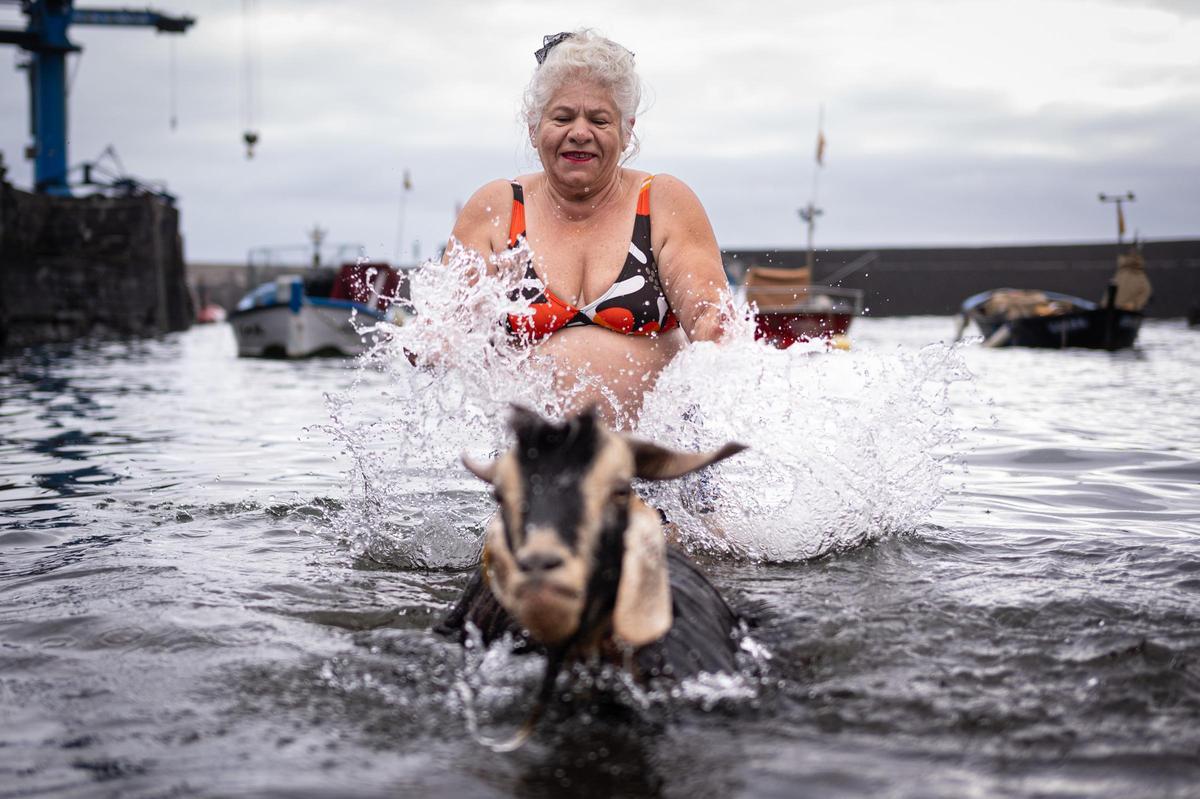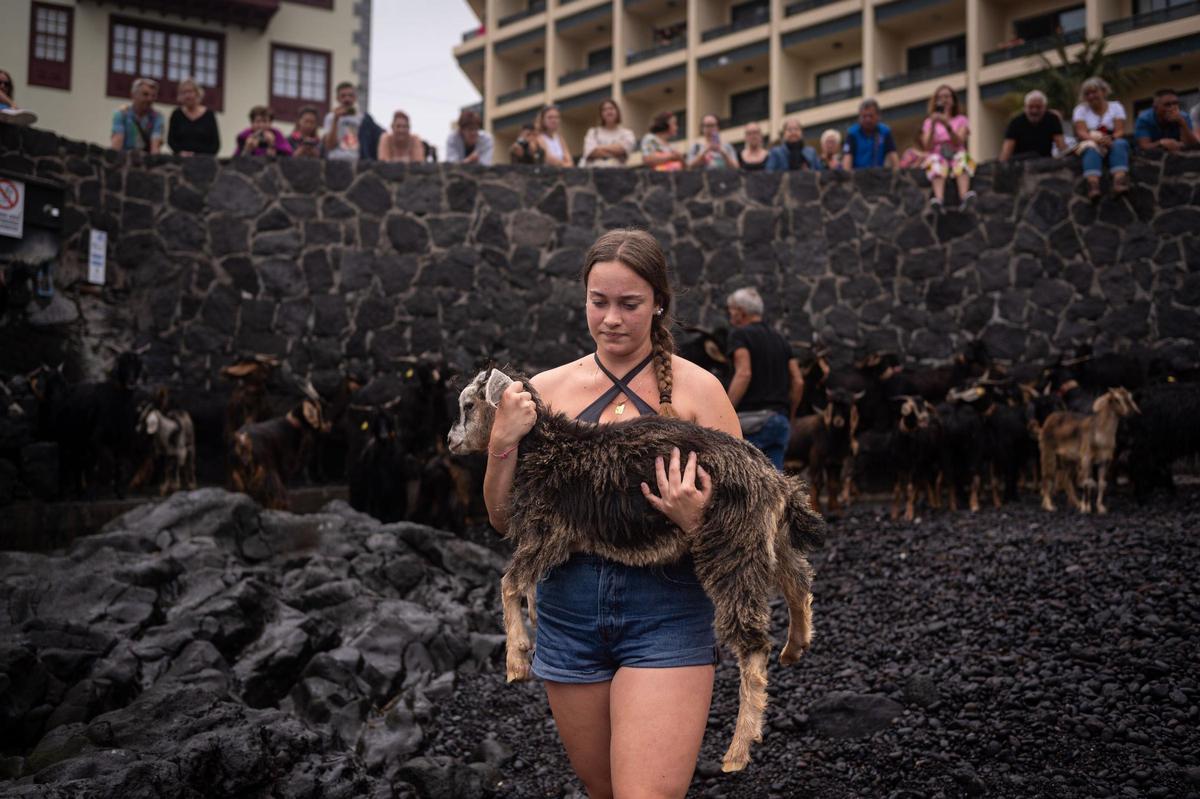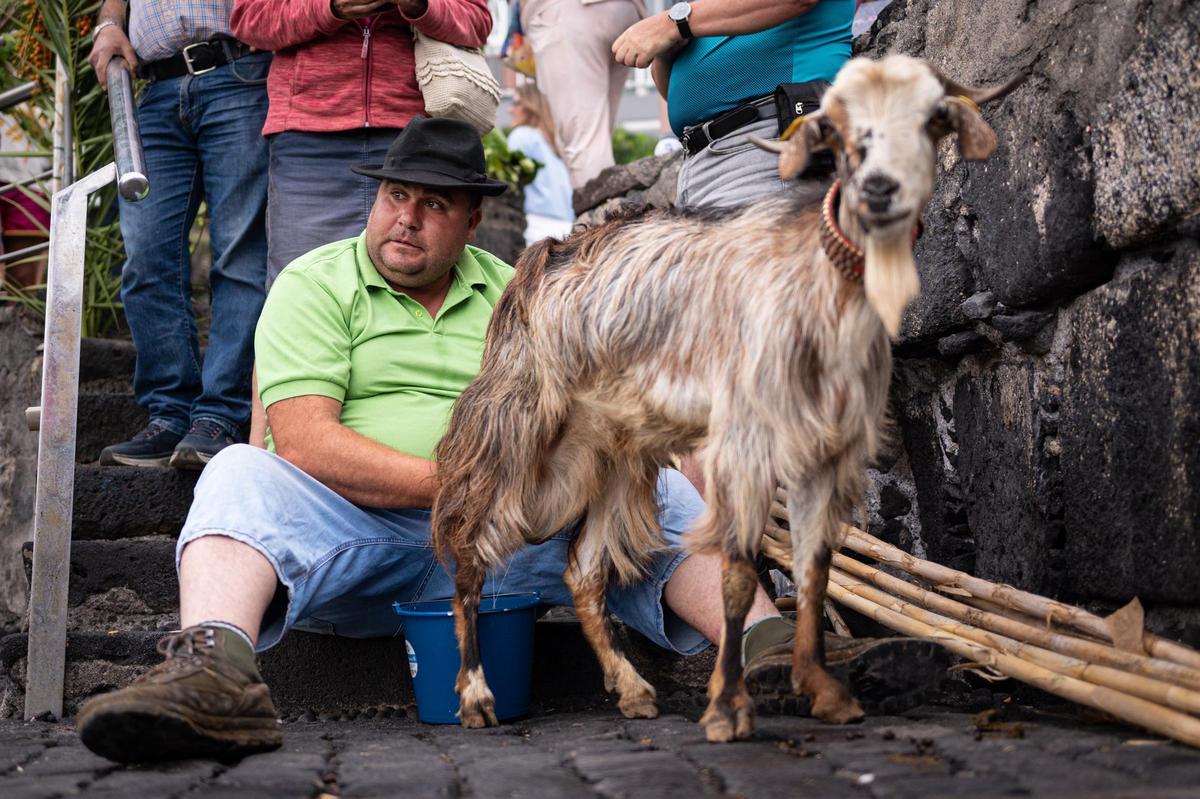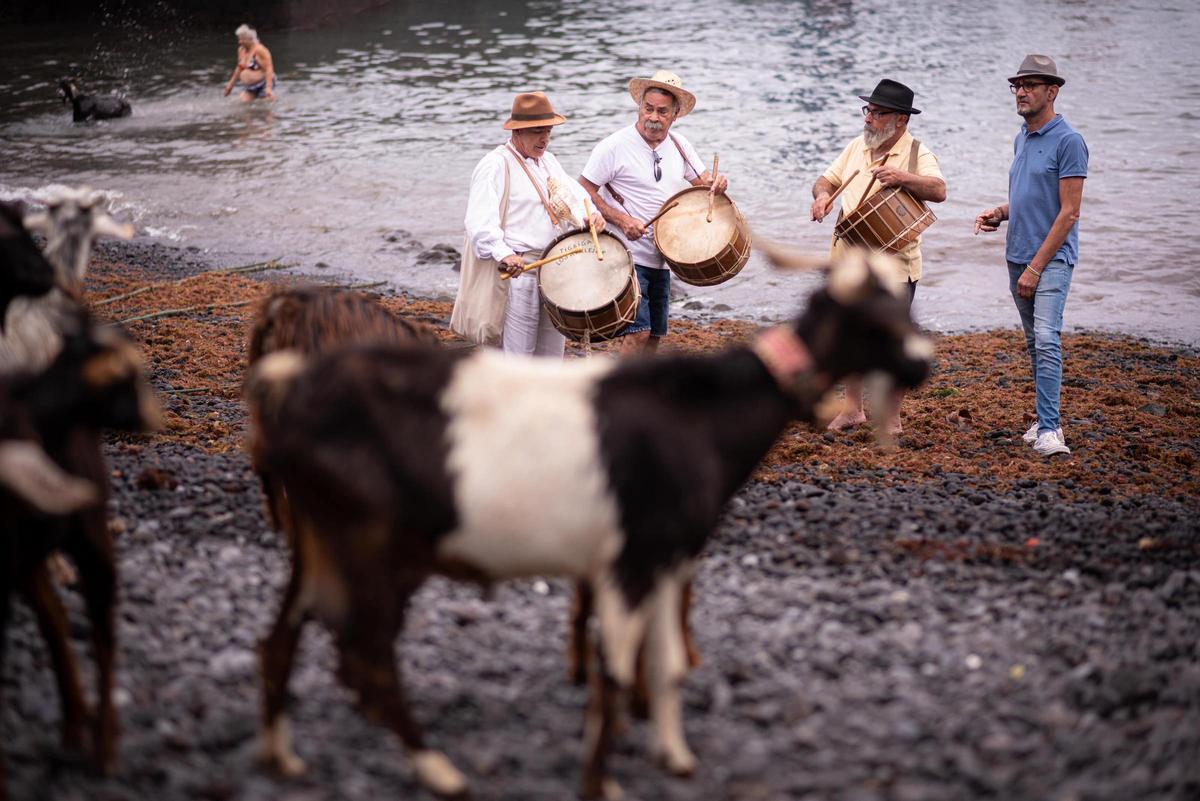Hundreds of goats woke up this Monday between four and five in the morning to attend the traditional goat bath on the feast day of San Juan at the beach of the dock in Puerto de la Cruz. The origin of this ritual dates back to the time of the ancient indigenous people of Tenerife who took their herds of goats to the coast, but it has endured to bring a piece of the Guanche world to the present day. The goal is to clean them, deworm them, and prepare them for mating. It happens on the morning of San Juan, after a night in which people lit bonfires on the beach to ward off evil spirits and celebrate one of the shortest nights of the year. Likewise, some shepherds link this ritual to a spiritual cleansing for the goats as they immerse the heads of these animals in the sea.
María Candelaria Alonso, 62 years old, came from Los Realejos and was one of the first goatherds to arrive at the beach. She did so at eight in the morning, but with an energy that seemed like it was already noon. She has spent her whole life learning the shepherding that she inherited from her father and grandparents and every year she attends the bathing of her goats.
The animals resisted entering the water. They dug their hooves into the stones and needed a push to take them to the shore. Even so, Alonso gathered strength and was able to get them into the water. The shepherdess needed great physical effort to grab each animal by the horns and venture into the sea up to her waist, but her excitement gave her enough energy to do it. At the same time, she enthusiastically interacted with her audience and exclaimed every time she grabbed a new goat, shouting: “Applaud, cheer for the goat!”.
On the other hand, hundreds of people were expectant for an unusual moment on the dock beach. They watched from the walls surrounding the beach. Some more curious ones went down to the shore to see these animals up close, but none took their eyes off the skill of the goatherds as they one by one immersed hundreds of horns on the shore of the sea.

María Candelaria Alonso with one of her goats. / Arturo Jiménez
The goats spend the whole year walking through ravines and abandoned estates between land and stones. As María Candelaria Alonso claims, the hooves of their legs are mistreated. Therefore, this ritual also represents a cleansing for the animals. In addition, the Guanche tradition sought that the small wounds they had would heal with saltwater. For Alonso, it is a very special and necessary day of the year. “It is an act of renewal for our goats”, she adds. On the other hand, other goatherds like Avelino Doniz highlight that this ritual favours the mating of these animals.
The youngest ones also collaborated. At the dock beach up to three generations of goatherds attended. One of them was Jimena Bello, 15 years old, who came with her grandfather and father to fulfil the tradition. They walked from La Vera, in the same municipality of Puerto de la Cruz to the coast. For her, every 24th of July is a very special day and she feels proud to be able to spend it with her relatives helping in an activity that they have instilled in her and requires so much vocation and effort. With great strength, due to the resistance the animals put up to walk to the shore and, although tired, she helped bathe the goats.

Daughter of goatherds carries a boat to bathe in the sea. / Arturo Jiménez
Yecenia Méndez and Ariadne Perera, both twelve years old, also collaborated with their families in the rite of their ancestors. The young girls grabbed the animals by the horns and gave them their first bath of the year. They also helped with the young goats who, as they are small, reached the shore held in their arms. For them, it is a tradition, and they comply with it with great emotion and accompanied by their relatives who are dedicated to shepherding.
Reviving the tradition
In the 1960s, the tradition fell into disuse due to the rise of the tourist sector, which considered that bathing animals in the presence of tourists was not appropriate. However, in 1984 it was recovered thanks to the Valle Taoro Cultural Collective, the historian and professor Manuel Lorenzo Perera, and the ethnographer Chucho Dorta. From 2002, and up to the present day, the Friends of the Goat Bath in the Sea Cultural Association has taken charge of its organization.
Although in the 1960s the importance of maintaining this tradition was questioned, the fact is that hundreds of curious onlookers approached once again to see this ancestral ritual on the morning of the feast of San Juan. Many repeated their visit to the coast of Puerto de la Cruz every year. On this occasion, they noted that not as many people had attended as in previous years and attributed this to it being a Monday. Nonetheless, the atmosphere was one of anticipation for what for many was a very curious performance.
**Early Morning Tradition of Goat Milking in Benijo**
Having woken up at four in the morning to milk the goats and starting the walk from [Benijo Beach](https://www.eldia.es/tags/playa-de-benijo/) to Puerto de la Cruz at six in the morning. “It’s an effort, but filled with so much excitement,” were the words that described the morning of the brothers who couldn’t miss the tradition. For the past 20 years, they have been coming and proudly talk about how difficult it is to be a shepherd and lamenting the loss of tradition: “This is a sacrifice, very tough, but it runs in the blood,” highlighted Avelino Doniz.

Shepherd milks one of his goats on the steps of the pier beach. / Arturo Jiménez
The morning wasn’t just filled with the bleating of goats. The scene was also set with musical pieces like the *tajaraste* with its drums, conch shells, flutes, and horns. Domingo Fernández, a veteran who attends this event every year, played them. At the same time, he sang along with songs that spoke of: “Long live the goats, long live the herders, milk with gofio is what I desire.” Following the song’s orders, some herders sat on the steps leading to the pier beach while milking their goats. They filled buckets with milk, strained it, and transferred it to plastic bottles to later sell them on the avenue. This completed a tradition that recreates a ritual from the Guanche origins whose main intention was to protect the livestock.

Drums, conch shells and flutes to accompany the morning. / Arturo Jiménez
The day doesn’t end with the goats’ bath. Herders such as Avelino and Víctor Doniz expect to arrive at their farms by ten in the evening. After plunging their nearly 300 goats one by one, they still have to return to Benijo from where they set off at six in the morning. For the brothers, this is an event they cannot miss. They hope to continue attending every year with the same enthusiasm that motivates them to wake up early and walk so many kilometres.
Professionals in the field like Oliver Tomás from Los Realejos emphasize how livestock farming is dwindling. He acknowledges that the youth are not interested in working in agriculture. “Those of us currently dedicated to this are because we enjoy it and have grown up with livestock since we were young,” he points out. Their hope is that this tradition, connecting an indigenous past with a time that brings herders closer to their ancestors, will not be eradicated.















